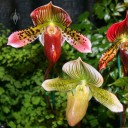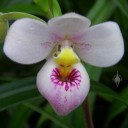Lady Slippers
Lady slippers, aka slipper orchids, amaze and inspire. Many orchid lovers specialize in growing these fascinating beauties. If you received a lady slipper gift for Mother’s Day, it’s most likely a Paph, or Paphiopedilum. Over 100 Paph species have been crossbred into countless hybrids. Their flowers all have a distinctive pouch which makes the blooms look enough like footwear to inspire the slipper nickname. Paphs are native to Southeast Asia and some South Pacific islands.
Paphs are certainly the most common slipper orchids, but there are also other varieties. Paphs, Phrags and Cyps have flowers with a pouch, and fortunately, they also have short nicknames. Phrags, or Phragmipediums, have brilliant colors and wild shapes. Phragmipedium kovachii, or PK, electrified the plant world in 2001 when its huge purple blooms were discovered in the Peruvian jungle. Other Phrags have petals which droop to the ground, reaching 2 ½ feet (76 cm) or more. Phrags are native to tropical jungles in Central and South America.
Cyps, or Cypripediums, include lady slippers native to the USA, Canada, Europe, and parts of Asia. They’re sometimes known as moccasin flowers. All types of lady slippers need regular watering and moist, shady conditions to mimic their homes near the rainforest floor. Most live as terrestrials, and need repotting every year or two. Paphs are easy to grow in a home or office, and are popular choices for novice orchid growers. Many Phrags and Cyps have special soil and watering requirements, and are best for experienced growers.
Explore posts in the same categories: Growing, Photos, Watering
Subscribe to the About Orchids Blog:
![]()









May 15th, 2012 at 7:00 pm
This is great! I think that this is one of your best sets yet. I love them all!!!
May 16th, 2012 at 2:51 am
Great photos, thanks for sharing.
May 16th, 2012 at 8:52 am
Really nice photos and great post with very interesting information. You might want to follow up to this topic!?! 2012
May 17th, 2012 at 9:01 am
Don’t forget that there are more members of the ladyslipper family too. Selenipedium and Mexipedium are small genera but considered ladyslippers too.
Very nice post. I’ve mostly grow ladyslippers in my collection for 20+ years and this is a beautiful sample of photos of the family. Of course, Phrags and Cyps really have specific growing requirements as you said. If you’re a beginner, stick the the Paphs!
May 30th, 2012 at 5:16 pm
[…] Since 77 native orchid species grow in the Bruce Peninsula, this is a rare opportunity to see wild lady slippers, grass pink orchids, Goodyeras, and other beautiful wildflowers in their full spring colors. […]
May 30th, 2012 at 8:44 pm
Wow! What amazing blooms. I’ve seen Lady slippers before, but never with such brilliant colors. The purples and pinks and oranges are almost neon. I could see how they could quickly become addictive.
June 9th, 2012 at 5:54 pm
yeah, what fab plants, I have 6 plants, one has been flowing constantly since last May.Mine even have names! Best place is definately the bathroom, lots of steam.And I even use warm water from the microwave to water them, too cold is a bit of a shock.
June 18th, 2012 at 2:23 pm
Stunning, really stunning pictures!
June 28th, 2012 at 8:31 am
[…] Lady slippers, Masdevallias, Miltonias, Odonts, Vandas, and Cymbidiums will enjoy daily soakings. […]
July 13th, 2012 at 10:43 am
Although you always have great photos like this, these are some of your best! I could stare all day at the phrag pictures, ahhh, they are just heavenly!